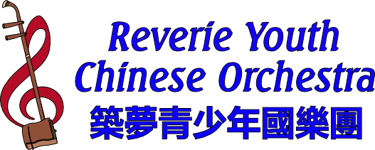
CHINESE ORCHESTRA HISTORY
History of Chinese Orchestra
The modern Chinese orchestra originated in the early 20th century when musicians and educators sought to standardize and improve the myriad Chinese regional musical traditions and instruments by adapting traditional Chinese instruments and music to modern Western musical scales, notation, and theory.
Ensemble music has always been an important part of Chinese culture and China has had a rich musical tradition for thousands of years. Music was considered one of the Six Confucian Arts (六艺) that all upstanding Chinese were expected to participate in. Traditional Chinese music consisted primarily of solo and folk ensembles that played for gatherings and seasonal festivals and activities. Rarely did a Chinese ensemble include more than one of a certain instrument. Some Chinese instruments still used today such as the dizhi, sheng, and guzheng, date back to antiquity, although the modern versions of these instruments are only about a century old.
Like the many languages and dialects spoken in imperial China, at the turn of the 20th Century, different regions of China had their own musical traditions featuring different musical styles, different instruments, and different musical tones and notation. As Western influence spread in China, many Chinese decided China should have a unified musical discipline like Europe.
When the Republic of China (中華民國) was founded in 1912, its leaders set about to create a Chinese national identity out of the diverse traditions, cultures, peoples, and countries that made up China's last imperial dynasty. The most important aspect of creating a national identity was to adopt a standard language for China, which occurred when Mandarin became China's first official language in 1932. They also sought to standardize and improve Chinese music.
In 1927, the Ministry of Culture of the Republic of China directed Tsai Yuan Pei (蔡元培) to establish the Shanghai Conservatory of Music (上海音樂學院). Tsai was a famous Chinese scholar who had previously been the president of Peking University, and founder of the Academia Sinica. While at Peking University, Tsai founded the Peking University Music Society in 1919 as a laboratory for modernizing Chinese music. For example, one of Tsai's faculty members, Liu Tien Hua (劉天華), redesigned the erhu to play Western scales and wrote compositions for the expanded pitch and range of the modernized instrument. Liu popularized the practice of having more than one player of a certain instrument in a Chinese ensemble, paving the way for a full Chinese orchestra.
In the 1920s and 1930s, scholars deployed across China to collect data about local music and instruments and synthesized their findings into a unified Chinese musical system. They studied the various regional variations of traditional Chinese instruments and created standardized versions with a standardized and expanded tuning. These standardized Chinese instruments ("reformed instruments") were then organized along the lines of the Western symphony orchestra. Chinese musical notation and musical tones were also standardized along Western lines.
The result is known as guoyue (國樂), literally National Music, or Chinese Orchestra. In guoyue, the musicians are arranged like a Western symphony orchestra with a conductor and sections made up of families of instruments. The reformed Chinese instruments correspond to the various sections. Many classic Chinese music pieces were rewritten for the new guoyue style. Because guoyue is only about a century old, it does not have the comprehensive body of works and scholarship when compared to the much older classical Western music. Therefore, guoyue borrows aspects of Western music and scholarship where there is no traditional Chinese precedent.
BIRTH OF THE CHINESE ORCHESTRA
After years of effort by scholars and musician to modernize Chinese instruments, techniques, and music, the modern Chinese orchestra finally arrived in the mid 1930s.
In 1935, the Central Broadcasting Company of China, later known as the Broadcasting Company of China (中國廣播公司 “BCC”) of Nanking, China, established the first modern professional Chinese orchestra (the "BCC Chinese Orchestra"). The BCC Chinese Orchestra was a landmark in the development of Chinese music. The BCC Chinese Orchestra established the definitive form of the modern Chinese orchestra: four sections (bowed string, plucked string, wind, percussion) with orchestra members facing the audience in a semi-circle formation around a conductor. All Chinese orchestras since that time, including all modern Chinese orchestras around the world, are modeled after the BCC Chinese Orchestra.
The BCC Chinese Orchestra originally performed only for on-air music programs on the BCC's radio network. The BCC Chinese Orchestra performed its first public concert in Chungking in 1942, where the Orchestra was based during the Second Sino-Japanese War. For the first time, Chinese music was presented as a true concert in a formal Western style concert hall rather than as a folk accompaniment to traditional festivals and activities. Since that time, Chinese orchestras have performed in the most prestigious concert halls around the world.
The BCC Chinese Orchestra expanded the range of traditional Chinese instruments and improved them to Western standards. The BCC Chinese Orchestra introduced new instruments to the Chinese orchestra including: zhonghu, dahu, dihu, and xindi to achieve the lower pitch range of Western orchestras.
The BCC Chinese Orchestra left Nanking in 1949 and relocated to Taipei, Taiwan where it continued its work performing and improving the Chinese orchestra. Meanwhile back in Mainland China, the Chinese orchestras there introduced several new instruments to the Chinese orchestra including: liuqin, zhuihu, yunluo and paigu, gehu, daruan, zhongsheng, and disuona and also rearranged many regional ensemble and folk music into full scores for a large symphonic orchestra.
Today, Chinese orchestras can be found throughout greater China and in overseas Chinese communities around the world. Despite its relatively short history, Chinese orchestra is now well established and proudly representing Chinese culture in countries all around the world.


